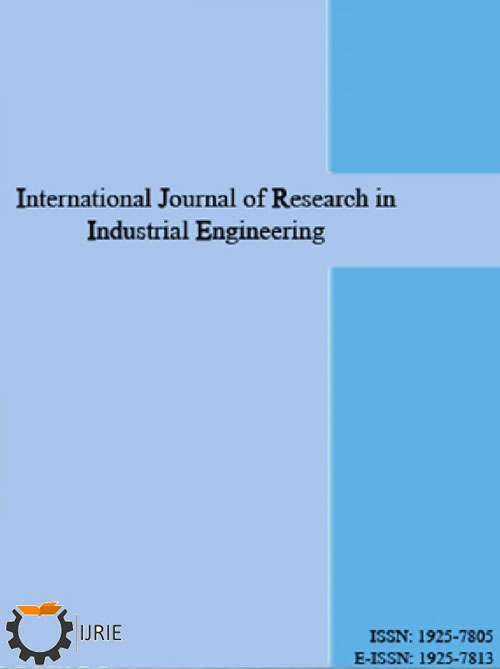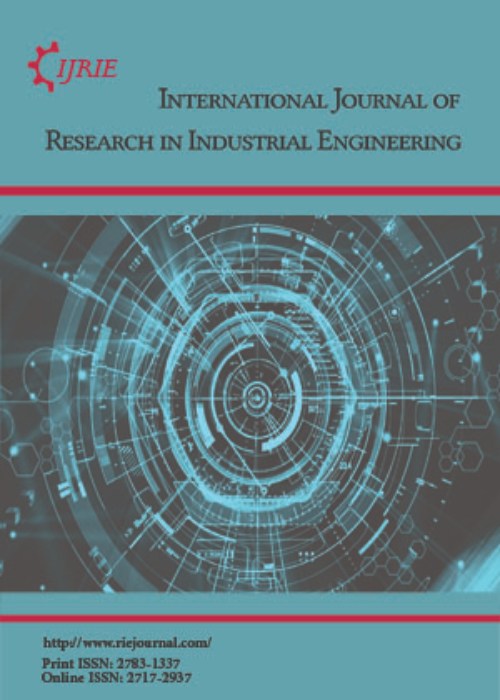فهرست مطالب

International Journal of Research in Industrial Engineering
Volume:11 Issue: 1, Winter 2022
- تاریخ انتشار: 1401/01/14
- تعداد عناوین: 7
-
-
Pages 1-8The Emergency Preparedness and Response (EPR) framework to a radiological emergency in a Nuclear Power Plant (NPP) accident should be developed systematically and efficiently by applying an appropriate methodology. A systematic approach is applied in this study to select the appropriate method from different methodologies for developing EPR framework of a NPP accident by applying trade-off analysis. Ten evaluation criteria, namely causal analysis, decision making analysis, feedback analysis, interactive graphical analysis, nonlinear behavior analysis, organizational factor analysis, quantitative analysis, sensitivity analysis, statistical analysis, and threat analysis were identified for methodology selection by conducting requirement analysis of EPR framework. The System Dynamics (SD) approach was found as the most capable and the best methodologies according to the trade-off analysis by considering the assigned criteria for EPR framework of a NPP accident. The Analytic Hierarchy Process (AHP) and the Bayesian Belief Network (BBN) can also be applied in the EPR framework development process of NPP accident.Keywords: Evaluation Criteria, EPR, NPP Accident, System Dynamics (SD), trade-off analysis
-
Pages 9-15Multi-label learning is an emerging research direction that deals with data in which an instance may belong to multiple class labels simultaneously. As many multi-label data contain very large feature space with hundreds of irrelevant andredundant features, multi-label feature selection is a fundamental pre-processing tool for selecting a subset of most representative and discriminative features. This paper introduces a Python-based open-source library that provides the state-ofthe-art information theoretical filter-based multi-label feature selection algorithms. The library, called PyIT-MLFS, is designed to facilitate the development of new algorithms. It is the first comprehensive open-source library for implementing algorithms of multilabel feature selection. Moreover, it provides a high-level interface that enables the end-users to test and compare different already implemented algorithms. PyIT-MLFS is available from https://github.com/Sadegh28/PyIT-MLFS.Keywords: Feature selection, Multi-Label Learning Library, Data mining
-
Pages 16-29
All governments especially those having a high risk of natural disasters must have a comprehensive and implementable plan. In Iran, the placement of relief centers for the injured is usually done experimentally by relief organizations without considering the necessary standards. In this research, according to the crisis management standard, the criteria are classified and determined as layers of information in the Geographic Information System (GIS). Then, the selected relief centers in the study area were evaluated according to the standard criteria and using the obtained matrix, the research criteria were weighed by entropy method. Finally, using net flows, performance scores and research constraints, the optimal options were identified by the PROMETHEE 5 method. The strengths and weaknesses of each of these options were also assessed. The results showed that half of the relief centers considered in the region were not optimal and had poor performance in most of the effective and important criteria for locating relief centers. Criteria of population density and distance from worn tissue were the most important criteria in this study.
Keywords: Location, PROMETHEE method, Geographical information system, Relief centers -
Pages 30-49Given the challenges and global uncertainties in the business’s, the use of futurism to improve management in space research center in Iran has become very important. Hence, space sector needs continuous futurology improvement in its systems and processes to obtain higher levels of reliability. Therefore, this study is aiming to design a model to create an organization with high reliability. So, this research is among developing research. In terms of the nature and approach of research, it is a causal-effect research, while it should also be noted that the present study is mixed by Grounded theory. This research has done based on qualitative part of the research and semi-structured interviews with 20 experts and knowledgeable experts in Iran Space Research Institute and active academic experts at universities. Firstly, categories and subcategories have been selected through individual interviews with experts in the field of reliability based on snowball sampling method. The statistical population of this research in a small part consists of active employees of the organization in the Iranian Space Research Institute of 1000 people. The statistical sample in this research is 277 people and the sampling method is also available. The results showed that, security activities, learning and experience survival, high interaction ability activities, job rotation and trust, high learning ability and difficulties at work activities, managers' special attention to supply line forces, high transfer rate, knowledge management, teamwork, loyalty and dignity, teamwork and collaboration, organizational knowledge management, commitment to flexibility, talent management and organized turmoil are essential to create a highly reliable organization.Keywords: organization, high reliability, space research
-
Pages 50-61
The current research has been done pursuing the goal to present a content marketing model with brand improving approach in banking industries. This study is applied in terms of goal and survey- exploratory concerning the approach. The statistical community is made up of a group of experts including the senior executives of the banking industries, academic faculty in marketing and marketing consultants acquainted with the banking industries who were posed in-depth interview. Selecting the experts and their interviews continued until reaching theoretical saturation and then stopped. In this research, snowball sampling method was used and this process continued until the researcher reaching theoretical saturation. And ultimately, the study finished with interviewing 9 experts. Since the data-driven theory has been utilized in this research, collecting the data has been mainly done by in-depth and unstructured interview. Finally, after three steps known as open, axial and selective coding, the conceptual model has been designed based on the paradigm model.
Keywords: Content Marketing, Brand, Data-driven Theory, Banking Industries -
Pages 62-76Accurate identification, attracting, and keeping the customers particularly loyal Customer Relationship Management (CRM) with the goal of optimum allotment of resources and achievement to higher profit is not a competitive profit, but it is a life persistence necessity of companies in virtual space. One of the challenges of companies in this part is how to identify the customer’s traits and the separation of different segments of them. Now Customer Lifetime Value (CLV) is the comparison priority in the segmentation of customers to congruous segments. The main goal of this research is to identify key or strategic customers using the RFM model. In this part after determining the amount of Recency, Frequency and Monetary (RFM) in, registered transactions of one store in Iran (Refah Chain Store) at a time about seven months from 23 September 2017 to 20 April 2018 (71161 transactions as final inputs were used), the weight of each variable according to the fuzzy Analytic Hierarchy Process (AHP) was determined. At the next stage customers using the K-means and Two-step’s algorithms were clustered and K-means the method according to the Silhouette index was the better algorithm of this letter. According to the results, customers were segmented into three parts and CLV was calculated and for identifying key or strategic customer segmentation, the clustering process was repeated and priorities of all clusters were indicated. Results of data analysis are below: Segment 3: customers of this segment were 3425 members and 11.5% of all company customers were the most loyal customers those are identified as golden customer's segment and all of the variables were higher than average of all data. This research identified the valuable customers for the shop, and it gives them a chance to choose goal customers and invest in them.Keywords: Customer Lifetime Value (CLV), Customer Relationship Management (CRM), RFM model, Segment
-
Pages 77-91
Existing systems for diagnosing heart disease are time consuming, expensive, and prone to error. In this regard, a diagnostic algorithm has been proposed for the causes of heart disease based on a frequent pattern with the B-mine algorithm optimized by association rules. Initially, a data set of disease is used to select a feature, so that it deals with a set of training features. Then, association rules are used to classify educational and experimental sets, and then the factors affecting heart disease are analyzed. The numerical results from the experiments of real and standard datasets of cardiac patients show that the average accuracy of the proposed method is approximately 98%, which has been tested on the Cleveland database that includes 76 features in the case of heart disease dataset, 14 features of which are related to heart disease. This paper also uses four common categories such as decision tree to build the model. The data set studied in this article contains 270 records as well as 14 features. The accuracy of predicting the results of the support vector machine classifications, k nearest neighbor, decision tree and simple Bayesian is 81.11%, 66.67%, 59.72% and 19.85%, respectively, which are relatively satisfactory results.
Keywords: Frequent pattern, Heart disease, Data mining, B-mine algorithm, Association rules


